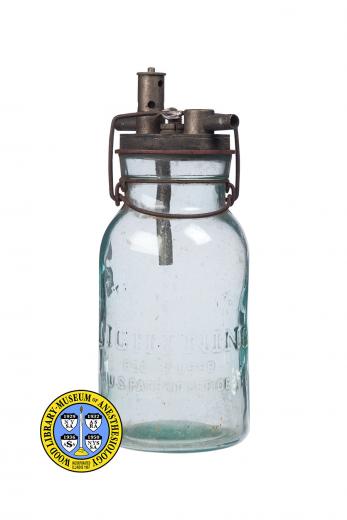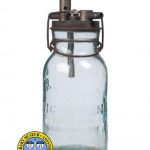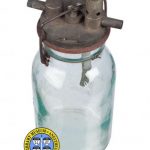Richardson Bottle
Dr. Frank L. Richardson (ca. 1878-1934) was a professional anesthesiologist who practiced in Boston in the early 1900s. In addition to clinical work, he published a number of articles on anesthesia, was an anesthesia instructor at Harvard, and was active in professional societies. He was the second physician to serve as president of the Boston Anesthesia Society (now the New England Society of Anesthesiologists). In the 1918 patent description, Dr. Richardson states that he wanted a simple, small and portable device that could deliver a continuous flow of oxygenated air and vaporized anesthetic under constant pressure and adjustable concentrations. For use, ether was poured into the glass jar and, to keep the ether from becoming cold as it vaporized, the jar was placed in a washbasin filled with hot water. The vaporized ether was delivered to the patient with air enriched with oxygen or oxygen and nitrous oxide. In 1913, two prominent anesthesiologists, Drs. Frederick J. Cotton and Walter M. Boothby, recommended Dr. Richardson's vaporizer as an, "efficient, simple, and inexpensive apparatus."
Catalog Record: Richardson Bottle
Access Key: akfh
Accession No.: 1978-04-06-1
Title: [ Richardson bottle / invented by Frank L. Richardson.]
Author: Richardson, Frank L. (Linden), d. 1934.
Title variation: Alt Title
Title: Richardson ether vapor apparatus.
Title variation: Alt Title
Title: Vapor or Gaseous fluid administering apparatus for anesthesia.
Title variation: Alt Title
Title: Volatile fluid vaporizing device.
Publisher: [Name of manufacturer not indicated : Location of manufacture not indicated,
1912-1920].
Physical Descript: 1 vaporizer : metal, glass : 25 cm x 10 x 10.5 cm.
Subject: Vaporizers.
Subject: Anesthesia, Inhalation – instrumentation.
Subject: Ether, Ethyl.
Note Type: General
Notes: Title taken from accession records for the item, from a small exhibit sign
once used for the item, and from the 1990 text, “Muscle Relaxants,” written
by S. Agoston and W.C. Bowman.
Note Type: Citation
Notes: Agoston S, Bowman WC. Muscle Relaxants. Amsterdam: Elsevier; 1990:3-4.
Note Type: Citation
Notes: Richardson bottle accession record. Located at: The archives of the Wood
Library Museum of Anesthesiology, Park Ridge, Illinois.
Note Type: Citation
Notes: Richardson FL. Some modern ideas about anaesthesia. Boston Med Surg J.
1915;173(26):943-946.
Note Type: Citation
Notes: Richardson FL, inventor; Teter Manufacturing Company. Vapor or gaseous fluid
administering apparatus for anesthesia. US patent 1,286,109. July 11, 1918.
Note Type: Physical Description
Notes: The vaporizer is composed of two main pieces: a large glass canning jar and
metal piece that is fixed to the jar with a metal clamp; The glass jar is
opaque but cloudy with a light bluish-green tint; It measures approximately 9
6 cm in diameter and 18.5 cm in height; The jar is moderately soiled; Raised
markings on the front of the jar include, “TRADEMARK [new line] LIGHTNING
[new line] REGISTERED [new line] U.S. PATENT OFFICE”; Raised markings on the
bottom of the jar include, “PUTNAM [new line] 62”; The jar is topped with a
very corroded metal piece, which is held in place with the jar’s metal
clamps; Compressed between the jar and the metal piece appears to be a gasket
for a canning jar (this would be consistent with the description in the
patent); The base of the metal top, from here forward to be called the “cap”,
measures only about 1 cm in height and 7.2 cm in diameter; The cap includes a
rotating piece, which can be adjusted from a mark of the letter “A” to
another mark of the letter “E”; Along an approximately 2.5 cm portion of the
side of the cap there appear to be seven hash marks indicating a scale
between the letters A and E; “S. HAPGOOD” appears to be engraved by hand into
the top of the cap; Two metal cylindrical shaped pieces rise vertically from
the cap; One is approximately 4.3 cm in height and 1.9 cm in diameter; Based
on the patent drawings it appears to house the valves for incoming air; Its
sides are punctured with six small holes; A port for incoming air or gas
mixture protrudes horizontally outward from the valve’s base; On the other
side of the cap, is the other cylindrical piece, which measures approximately
1.5 cm in height and 1.9 cm in diameter; This smaller cylinder may contain
the valves for outgoing air and vapor; From the base of this a port for
outgoing air and vapor mixture extends horizontally; From the bottom of the
cap a cylindrical tube extends about 7 cm into the jar just below the housing
for incoming air; The glass is too cloudy to see any further detains of the
bottom of the cap.
Note Type: Reproduction
Notes: Photographed on January 15, 2013 by Mr. Steve Donisch.
Note Type: Acquisition
Notes: Donated to the WLM by Dr. Martin Guttfeld.
Note Type: Historical
Notes: Dr. Frank L. Richardson (1878?-1934) was a professional anesthesiologist who
practiced in Boston in the early 1900s. In addition to clinical work, he
published a number of articles on anesthesia, was a professor at Harvard, and
was active in professional societies. In fact, he was the second physician to
serve as president of the Boston Anesthesia Society (now the New England
Society of Anesthesiologists) in 1922-1923. According to the 1918 patent
description, Dr. Frank L. Richardson developed this vaporizer because he
wanted a simple, small and portable device that could deliver a continuous
flow of oxygenated air and vaporized anesthetic under constant pressure and
adjustable concentrations. For use, ether was poured into the glass jar and,
to keep the ether from becoming cold as it vaporized, the jar was placed in a
washbasin filled with hot water. The vaporized ether was delivered to the
patient with air enriched with oxygen or oxygen and nitrous oxide. In 1913, two
prominent anesthesiologists, Frederick J. Cotton and Walter M. Boothby,
recommended Dr. Richardson’s vaporizer as a, “efficient, simple, and
inexpensive apparatus.”
Note Type: Provenance
Notes: This item was given to Dr. Martin Guttfeld by Dr. Lyman Hapgood in the early
1940s.
Note Type: Publication
Notes: Boothby WM. Ether percentages. JAMA. 1913;61(11):830-834.
Note Type: Publication
Notes: Richardson FL. Spinal anesthesia: some special indications for its use and
technique. Med Surg Rep Boston City Hosp. 1913;16:291-296.
Note Type: Publication
Notes: Richardson FL. Anesthesia for prostatectomy. Urol Cutaneous Rev.
1917;21(11):636-637.
Note Type: Publication
Notes: Richardson FL. Heart lesions in anesthesia. Am J Surg Anesth Suppl. October,
1919;33(10):109-112.
Note Type: Exhibition
Notes: This item was displayed in the WLM museum gallery at the ASA headquarters
building on Northwest Highway from 1999 to 2010. Selected for the WLM website
(noted February, 2013).



